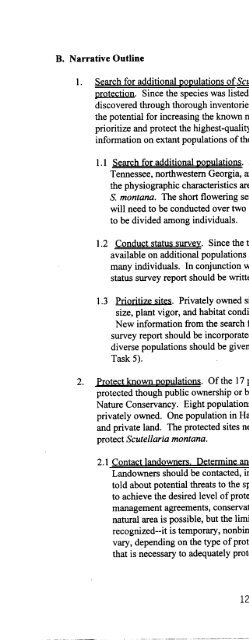Large-flowered Skullcap Recovery Plan - U.S. Fish and Wildlife ...
Large-flowered Skullcap Recovery Plan - U.S. Fish and Wildlife ...
Large-flowered Skullcap Recovery Plan - U.S. Fish and Wildlife ...
You also want an ePaper? Increase the reach of your titles
YUMPU automatically turns print PDFs into web optimized ePapers that Google loves.
.<br />
B. Narrative Outline<br />
1.Search for additional populations of Scutellaria montana <strong>and</strong> prioritize sites for<br />
~tQI~IQn. Since the species was listed, several additional populations have been<br />
discovered through thorough inventories of specific areas. Without a focused effort,<br />
the potential for increasing the known number ofpopulations is slim. The ability to<br />
prioritize <strong>and</strong> protect the highest-quality sites will depend on having complete<br />
information on extant populations ofthe species.<br />
1.1 Search for additional populations. A search should be conducted in southeastern<br />
Tennessee, northwestern Georgia, <strong>and</strong> the northeastern corner of Alabama, where<br />
the physiographic characteristics are consistent with the known habitat for<br />
S. montana. The short flowering season for the species may mean this search<br />
will need to be conducted over two field seasons orthat the search area will need<br />
to be divided among individuals.<br />
12 Conduct status survey. Since the time oflisting, information has become<br />
available on additional populations <strong>and</strong> field observations have been made by<br />
many individuals. In conjunction with a search for additional populations, a<br />
status survey report should be written to synthesize new information.<br />
1.3 ~iiIj~~j~. Privately owned sites should be ranked according to population<br />
size, plant vigor, <strong>and</strong> habitat condition. High-priority sites should be protected.<br />
New information from the search for additional populations <strong>and</strong> the status<br />
survey report should be incorporated as it becomes available. Genetically<br />
diverse populations should be given priority over those with low diversity (see<br />
Task 5).<br />
2. Protect known populations. Of the 17 populations currently known, eight are<br />
protected though public ownership or by the Tennessee River Gorge Trust <strong>and</strong> The<br />
Nature Conservancy. Eight populations, including the second <strong>and</strong> third largest, are<br />
privately owned. One population in Hamilton County, Tennessee, occurs on public<br />
<strong>and</strong> private l<strong>and</strong>. The protected sites need management plans in order to effectively<br />
protect Scutellaria montana.<br />
2.1 Contact l<strong>and</strong>owners. Determine <strong>and</strong> provide appropriate level of protection<br />
L<strong>and</strong>owners should be contacted, informed that S. montana is on their l<strong>and</strong>, <strong>and</strong><br />
told about potential threats to the species. If possible, negotiations should begin<br />
to achieve the desired level ofprotection. Types ofprotection include<br />
management agreements, conservation easements, <strong>and</strong> acquisition. Registry as a<br />
natural area is possible, but the limitations to this type ofprotection need to be<br />
recognized--it is temporary, nonbinding protection. The cost ofthis task will<br />
vary, depending on the type ofprotection possible <strong>and</strong> the amount ofbuffer l<strong>and</strong><br />
that is necessary to adequately protect the site.<br />
12

















